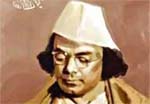 Eid festival traditionally begins with the popular Nazrul song O mor ramjan-er oi rojar sheshe elo khushir Eid. As soon as the moon of the Shawal month of the Arabic calendar comes to sight, the radio and TV channels play this timeless Nazrul song written by national poet Kazi Nazrul Islam, carrying the message of the festivity.
Eid festival traditionally begins with the popular Nazrul song O mor ramjan-er oi rojar sheshe elo khushir Eid. As soon as the moon of the Shawal month of the Arabic calendar comes to sight, the radio and TV channels play this timeless Nazrul song written by national poet Kazi Nazrul Islam, carrying the message of the festivity.
The song fits the genre of Islamic songs by Nazrul. But not only this song, Nazrul’s numerous numbers of Islamic songs and hamd and naat are still popular for their strong lyrics and messages. These songs are also frequently played on radio and TV channels throughout the Ramadan during the iftar (break of fasting) time.
In fact, these Nazul songs are inseparable part of the Ramadan and Eid celebrations.
Ami jodi arab hotam, Bajhchhe damma badhre amama, Dhormer pothey shahid jara amra shei jati, E kon mudhur sharab dile, Hera hote ele dule, Hey rasul bujhi nai ami, Khoda tomar meherbani, Masjid-eri pashey amar kabor dio bhai, Mone boro asha chhilo jabo modinay, Nobi mor porosh moni nobi mor shonar khoni, Tora dekhey ja amina mayer koley and many more are the examples of timeless Islamic songs by Nazrul which are played in the month of Ramadan.
According to experts, the Islamic songs of Nazrul represents his attempts in exploring the Islamic practices of namz (prayer), roja (fasting), hajj (pilgrim) and zakat (charity). But on the other hand, he also narrates the beauty of Islamic stories in many of his Islamic songs.
The Islamic songs of Nazrul convey messages to change the society and remove prejudice and build a better society with the purity of Islam, said a researcher at the Nazrul Institute.
Nazrul’s hamd and naat describe Allah, Rasul and different characters in the Islamic world and call upon human beings to lead a peaceful Islamic life.
Eminent Nazrul singer Ferdous Ara says, ‘His hamd and naat create a soothing feeling on mind.’
Nazrul did not only highlight the spirit of Islam in his Islamic songs. As a revolutionary, he used the references of the Muslim legends to inspire people against the British imperialism.
‘He has been compared to William Butler Yeats for being the first Muslim poet to create imagery and symbolism of Muslim historical figures such as Qasim, Ali, Umar, Kamal Pasha, Anwar Pasha and the prophet Muhammad,’ said professor Tauhidun Nabi, a Nazrul of Nazrul Institute.
His works also highlight the leading women of Muslim world. Nazrul has described the bravery of famous women including Bibi Fatema, Bibi Rahima, Rizia, Chad Sultana and others through his songs. His pledges to enlighten the women with the golden touch of Islam are hidden in such Islamic songs.
Nazrul was a voice against bigotry, injustice, oppression and inequality of all kinds. His timeless songs will always be the part of the Eid and Ramadan celebrations of the Bengalis, observed Nazrul experts.
-With New Age input




















